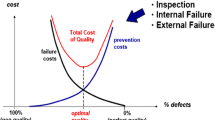Abstract
The purpose of this paper is to show the power of the Six Sigma methodology in satisfying the requirements of the automotive market. The company of this project produces cooling air pipes for deluxe vehicles. The problem solving method applied was the DMAIC (Define, Measure, Analyse, Improve, Control). This process review takes into account the increased quality standards of the output; therefore, the real problem was not to increase the system productivity, but to eliminate those process features that the automotive market considers as defects. For example, identifying the CTC (Critical to Customer), the main defect categories were: scraps on the pipes, blows on the devices and contamination of chip. The paper shows all steps of the Six Sigma implementation suggesting the solution to increase the process performance.
Access this chapter
Tax calculation will be finalised at checkout
Purchases are for personal use only
Preview
Unable to display preview. Download preview PDF.
Similar content being viewed by others
References
Pande, P., Holpp, L., (2002), What is Six Sigma?, McGraw Hill, New York, 2–3.
Yang, K., El-Haik, B., (2003), Design For Six Sigma, McGraw Hill, New York.
Adams, C, Gupta, P., Wilson, C, (2003), Six Sigma Deployment, Butterworth Heinemann, Amsterdam.
Brussee, W., (2004), Statistics for Six Sigma Made Easy!, McGraw-Hill, New York, 13.
Brue, G., (2003), Six Sigma for Manager, McGraw-Hill, New York, p.4.
Basu, R., Wright, J. N., (2004), Quality Beyond Six Sigma, Butterworth Heinemann, New York, 36.
Pande, P., Holpp, L., (2002), What is Six Sigma?, McGraw Hill, New York, 56.
Pyzdek, T., (2003) The Six Sigma Handbook, New York, McGraw-Hill.
Stamatis, D.H., (2002), Six Sigma and Beyond Foundations of Excellent Performance, Volume I, St. Lucie Press, New York, 120.
Breyfogle, F.W III, Meadows, B., (2000), The Six Sigma Implementation Process, Smarter Solution Inc, www.smartersolution.com.
Author information
Authors and Affiliations
Editor information
Editors and Affiliations
Rights and permissions
Copyright information
© 2005 CISM, Udine
About this paper
Cite this paper
Aggogeri, F., Gentili, E. (2005). Six Sigma Methodology: A Possible Solution to Increase the Process Capability in the Automotive Market. In: Kuljanic, E. (eds) AMST’05 Advanced Manufacturing Systems and Technology. CISM International Centre for Mechanical Sciences, vol 486. Springer, Vienna. https://doi.org/10.1007/3-211-38053-1_67
Download citation
DOI: https://doi.org/10.1007/3-211-38053-1_67
Publisher Name: Springer, Vienna
Print ISBN: 978-3-211-26537-6
Online ISBN: 978-3-211-38053-6
eBook Packages: EngineeringEngineering (R0)




